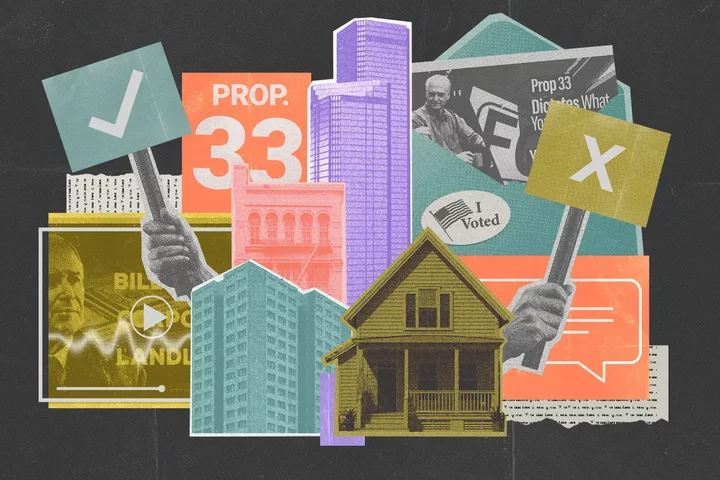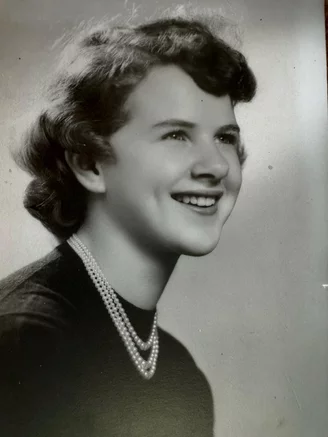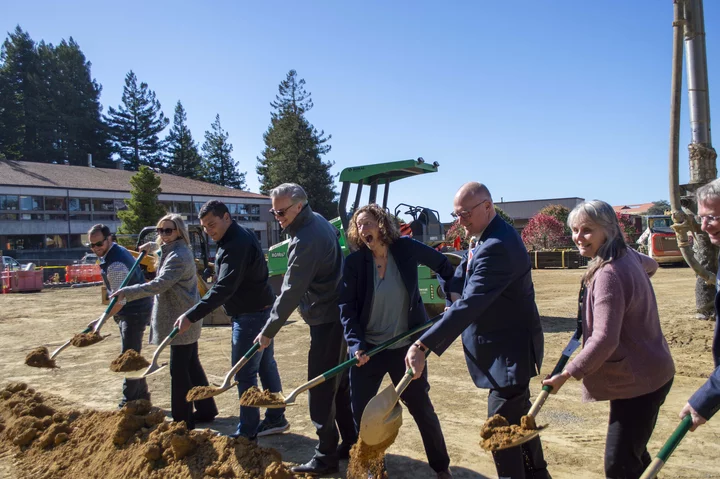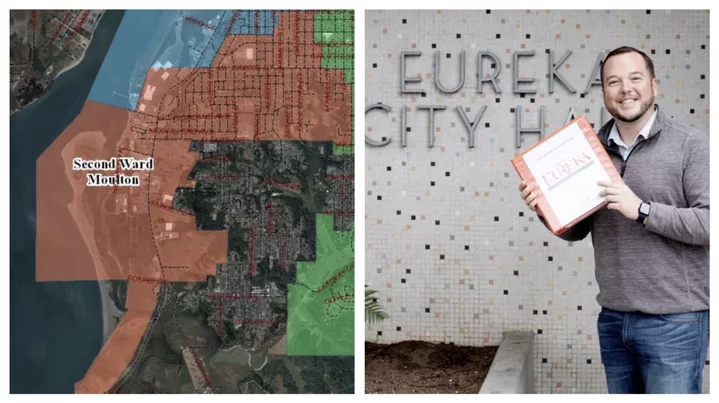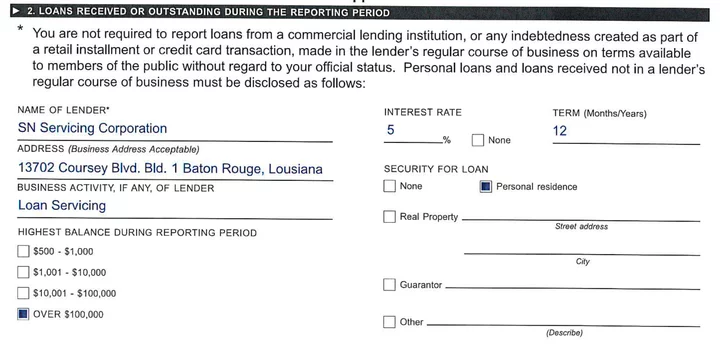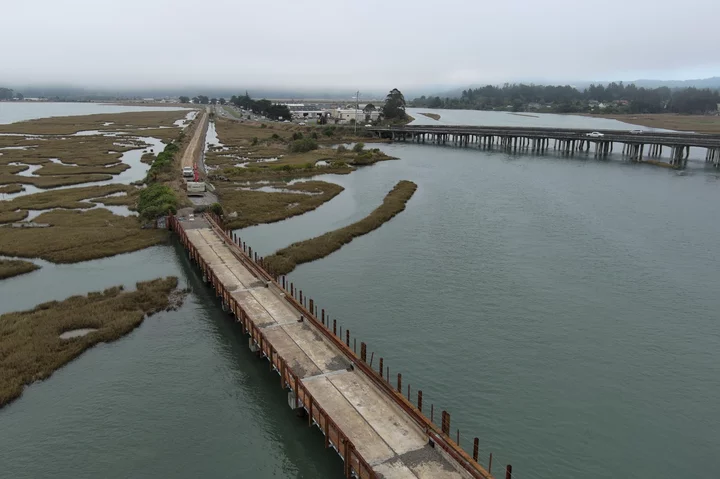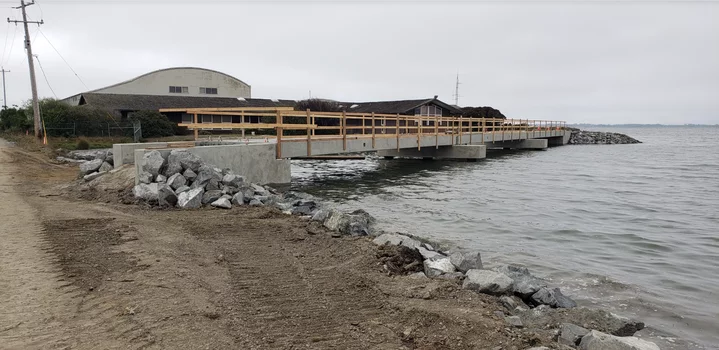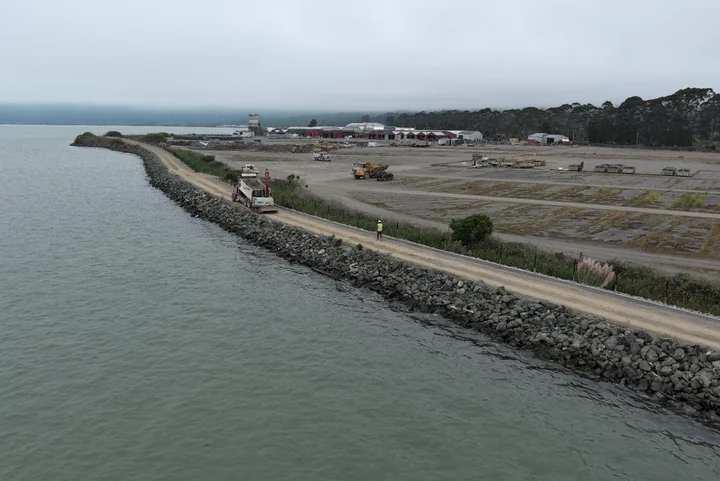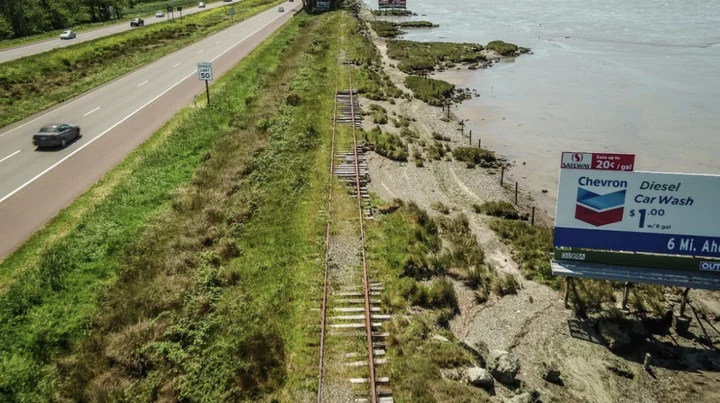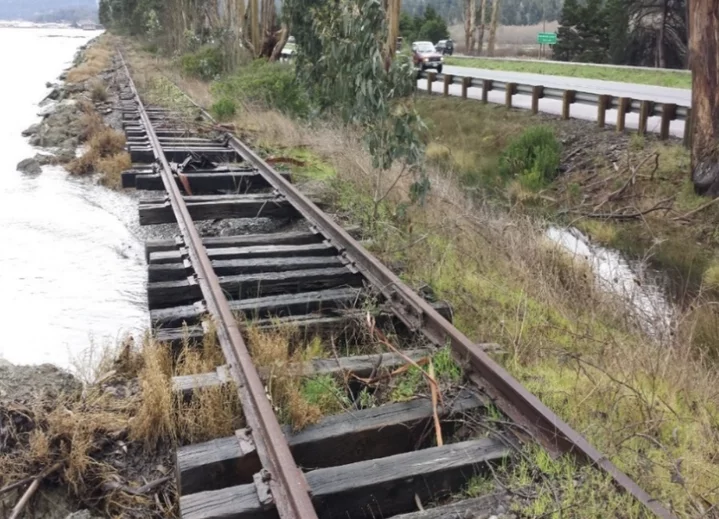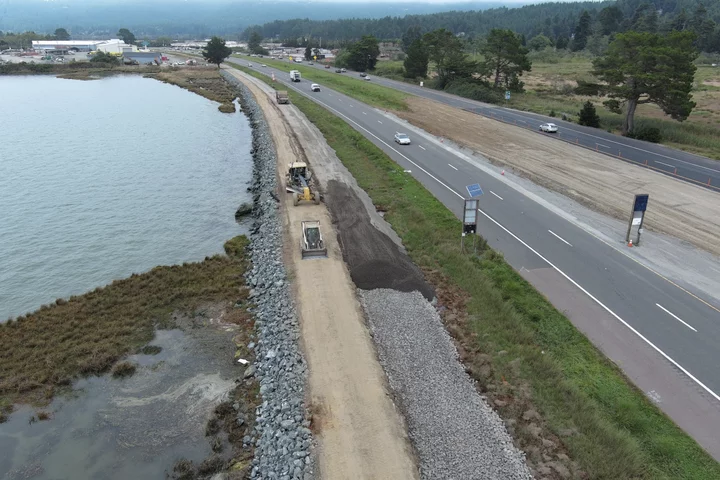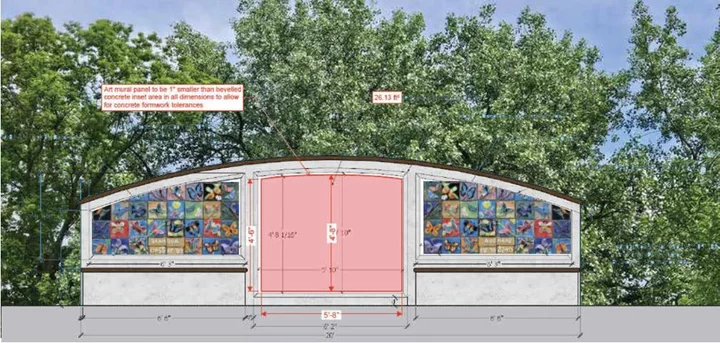Outside Groups Are Spending Millions in California’s Swing U.S. House Races. Will It Make a Difference?
Yue Stella Yu / Friday, Oct. 18, 2024 @ 7:30 a.m. / Sacramento
Voters began seeing dueling ads last month in one of California’s most contested congressional districts — a rematch between former Democratic Assemblymember Rudy Salas and GOP Rep. David Valadao.
Only a sliver of those ads were paid for by their own campaigns.
The candidates have each released a 30-second spot, touting their farming roots and their pledge to represent working families. But in far more TV ads, funded by other political groups, they are portrayed as out of touch with the working class and cast in gloomy monotone color.
Outside political organizations, independent from candidates’ campaigns, are buying airtime and driving the spending war between Democratic and Republican candidates in five of California’s tightest congressional races, campaign finance records show.
In those close contests from the Central Valley to Southern California, outside groups spent a total of $71 million as of Thursday — almost twice the amount candidates themselves have spent this election, according to data from OpenSecrets, a Washington, D.C.-based campaign finance watchdog group.
That money war highlights the importance of California to control of the U.S. House, even though the state is overall safely Democratic, said Jack Pitney, a politics professor at Claremont McKenna College.
“The path to the speakership runs through California,” Pitney said.
The spending blitz comes as Republicans try to fend off Democratic challengers and defend their eight-seat House majority. Both GOP House Speaker Mike Johnson and House Democratic leader Hakeem Jeffries campaigned for swing district candidates in California this week.
But in six of the most competitive California districts, Republicans were outraised by Democrats by almost 300% between July and September, according to the latest federal campaign finance filings.
Salas, for example, raised $1.8 million from individuals and political committees, while Valadao raised just $727,000, records show. In another competitive Central Valley seat, Democratic businessman Adam Gray raised $2.3 million while incumbent GOP Rep. John Duarte raised just shy of $500,000.

Democratic congressional candidate Rudy Salas speaks to a crowd of volunteers at the International Brotherhood of Electrical Workers in Bakersfield on Oct. 15, 2022. Photo by Larry Valenzuela, CalMatters/CatchLight Local
Similarly, in southern California’s 27th, 41st and 47th congressional districts, Democrats more than doubled Republicans’ fundraising for the third quarter. In Orange County’s 45th District, Derek Tran — a Democratic workers rights advocate — raised almost $2 million, while GOP Rep. Michelle Steel reported raising $1.3 million, including $1 million from herself.
That shows the waning influence of former GOP House Speaker Kevin McCarthy of Bakersfield and the rise of California’s Democratic Reps. Peter Aguilar and Ted Lieu as chairperson and vice chairperson of the House Democratic Caucus, respectively, said Democratic strategist Garry South.
“These are the seats that Democrats are going to have to flip … if they are going to take back the House,” he said.
But fundraising by candidates is only part of the money game.
Congressional Leadership Fund, a juggernaut Republican political action committee tied to House Speaker Johnson, plans to spend a total $40 million in California’s battleground districts — more than in any other state, a spokesperson confirmed to CalMatters.
“California remains an essential battleground for holding the House majority, which is why we’ve made such substantial and comprehensive investments in the state,” Dan Conston, president of the group, said in a statement.
House Majority PAC, its Democratic counterpart, has also booked more than $40 million in ads across the state, according to press secretary Alisha Heng.
“House Democrats are well-positioned and have the momentum, and we will flip the House blue and elect Hakeem Jeffries as Speaker in November,” she said in a statement.
A similar rivalry is playing out between the Democratic Congressional Campaign Committee and the National Republican Congressional Committee, the campaign arms of House Democrats and Republicans.
As of last week, the House Democratic campaign had spent $6.3 million airing ads in California’s Central Valley districts and has since launched a mobile billboard campaign across 27 swing districts nationwide — including six in California — to target the conservative “Project 2025” policy playbook.
“Our California challengers are lapping the competition in fundraising and meeting voters where they are,” Dan Gottlieb, spokesperson for the Democratic Congressional Campaign Committee, said in a statement.
Its GOP counterpart had spent $4 million as of last week running ads in four districts in the Central Valley and northern Los Angeles County, according to federal campaign finance filings.
“California House Republicans built strong fundraising totals this cycle, our message is resonating with voters and we have significant investments to reach voters in the final stretch,” said spokesperson Ben Petersen.
“The path to the speakership runs through California.”
— Jack Pitney, a politics professor at Claremont McKenna College
Others are also jumping into the fray.
America PAC, a pro-Donald Trump super PAC created by Tesla CEO Elon Musk, has spent $3 million boosting Republicans in three California House races — more than any other state, according to data from OpenSecrets. And cryptocurrency-linked super PACs have also invested millions of dollars supporting Republican incumbents in three swing districts in California: $2.8 million for Steel, $1.3 million for Valadao, and $1 million for Rep. Mike Garcia, POLITICO reported.
The ad blitzes by outside groups, however, aren’t always as cost-effective as candidates’ own spending, experts say. Non-candidate political groups must pay higher ad rates — sometimes in California’s most expensive TV markets, they noted.
“You talk about advertising in L.A., one week of television for a super PAC buy for a congressional race can be $2.5 million,” said GOP consultant Jon Fleischman.
And attack ads funded by outside organizations could be so negative that they risk turning voters off, strategists say.
“Voters don’t read the fine print. They don’t read the disclaimers on the ads,” South said. “All of that negative advertising is basically attributed by the voters to the candidate, not to some outside PAC they’ve never heard of.”
###
CalMatters.org is a nonprofit, nonpartisan media venture explaining California policies and politics.
BOOKED
Yesterday: 6 felonies, 15 misdemeanors, 0 infractions
JUDGED
Humboldt County Superior Court Calendar: Today
CHP REPORTS
Summer Ln / Scenic Creek Dr (HM office): Missing Indigenous
ELSEWHERE
Growing Pains, with Nick Flores: #227 - Conspiracies, Redemption, and Truth with Tyler Parr
RHBB: CHP Releases Name of Victim of Hwy 36 Motorcycle Crash
RHBB: Cal Poly Report Shows Humboldt’s Inflation Above State, National Averages
RHBB: Long-Term Road Repairs Begin August 4 on Kneeland Road Near Freshwater Park
We Fact-Checked the Ads About Proposition 33, California’s Rent Control Ballot Measure.
Felicia Mello / Friday, Oct. 18, 2024 @ 7:23 a.m. / Sacramento
Illustration by Adriana Heldiz, CalMatters.
Confused about Proposition 33? You’re not alone. A recent poll shows the ballot measure to give local governments more ability to limit rent increases is running neck and neck, with nearly a third of voters undecided.
Prop. 33 would repeal a state law known as the Costa Hawkins Rental Housing Act that prevents local governments from controlling rent on single-family homes, homes built after 1995 (or earlier in some cases), and when tenants move out. If it passes, local governments could create whatever measures they want to limit annual rent increases, and the state couldn’t intervene.
Tenant advocates largely support Prop. 33. Landlords are bankrolling the campaign against it. Democratic officials are split: Some side with tenants on the importance of keeping rents down on existing homes. Others are more focused on increasing overall housing supply, and want to make sure homes are profitable for developers to build and landlords to operate.
You wouldn’t necessarily know all this from the attack ads airing on TV and mailers fluttering into Californians’ mailboxes. Both sides say they stand for affordable housing, and some of the arguments have included a few head-scratching claims. We fact-checked some of those claims, so you don’t have to.
Claim: Prop. 33 would repeal more than 100 state housing laws, including affordable housing requirements and eviction protections.
Ken Rosen, a UC Berkeley business school professor, makes this claim in a No on 33 video ad. Opponents of Proposition 33 argue that it would give cities who don’t want to build housing a way to undercut new development: by mandating rents so low that developers couldn’t afford to build. They say that could make it hard to enforce recent state laws aimed at addressing the housing crisis, such as the “builder’s remedy” that relaxes zoning rules in cities whose housing plans haven’t been approved by the state.
“A city would be able to create the economic conditions to basically ignore those laws and requirements,” says Nathan Click, a spokesperson for the No on 33 campaign.
But that’s not the same as repealing those laws. And California courts have held that rent control policies are unconstitutional if they don’t allow landlords to earn “a just and reasonable return on their property” — meaning any city that tries to force landlords to charge obviously unfeasible rents, such as $1 per month, could face legal challenges.
Verdict: False.
Claim: Prop. 33 could create over 500 local rent boards
A No on 33 mailer makes this claim, pointing out that the rent boards would have the “power to regulate single-family homes, add fees to housing, and even dictate what you can charge to rent out your own home.”
There are just under 500 cities in California, and all of them could theoretically create rent boards to regulate local rents, whether or not Prop. 33 passes. Under Prop. 33, those boards would be able to cap rent increases on single-family homes, potentially affecting income for both corporate and mom-and-pop landlords. Rent boards can charge landlords fees to cover their operating costs — in San Francisco, for example, it’s $59 per unit — but current law already allows them to do that and would not change under Prop. 33.
Verdict: Mostly true.
Claim: ‘Rent control is an American tradition for over 100 years.’
This, from a Yes on 33 video featuring actor Blair Underwood, is pretty accurate. “Fair rent” committees sprang up in dozens of United States cities in the early 1920s, and rent control became widespread during World War II, helping drive an increase in homeownership. However, more than 30 states have since passed laws banning local rent control. In the states that do allow some form of rent regulation — including California and New York — more than 200 local governments have passed measures limiting how much landlords can charge, according to the National Apartment Association.
Verdict: Mostly true.
Claim: Prop. 33 would repeal the strongest rent control law in the nation
No on 33 campaign ads make this claim, saying the proposition would erase California’s “progress on housing” by getting rid of a law signed by Gov. Gavin Newsom. Newsom signed a law in 2019 that caps rent increases in California at 5% plus the rate of inflation, or a maximum of 10%. (The No campaign, staffed by the governor’s longtime advisor, Click, lists Newsom as an endorser.)
Prop. 33 doesn’t repeal this law, which is set to expire in 2030. It would, however, add this sentence to state law: “The state may not limit the right of any city, county, or city and county to maintain, enact, or expand residential rent control.”
Proponents say cities need this flexibility to keep annual rent increases below 10%, a rate they say still puts a big burden on tenants. Opponents argue that cities could also use this freedom to allow rents to soar higher than the state cap. But legal experts disagree about whether Prop. 33 might actually allow that: Deepika Sharma, housing clinic director at the University of Southern California’s Gould School of Law, said the rent cap “is not preempted by overturning Costa Hawkins,” while UC Davis law professor Chris Elmendorf said the proposition could create “a lot of legal murk about how conflicts would be resolved.”
Verdict: Mostly false.
Claim: ‘Stanford and UC experts agree Prop.33 will make the housing crisis worse’
This claim comes from a No on 33 audio ad. The chair of UC Berkeley’s Fisher Center for Real Estate and Urban Economics, Ken Rosen, appears in a No on 33 ad and has argued that Costa Hawkins needs to be preserved or construction will slow and landlords will pull rental units off the market. This echoes the view of many economists at California’s elite universities and elsewhere that rent control reduces rental supply, a view that’s backed by some empirical studies.
But other economics and policy researchers — particularly those who believe in a stronger role for government in solving social problems — see rent control as part of the solution to housing insecurity.
“Rent regulations support those who need it most, including those who are not being adequately and safely served by the current set of regulations that provide landlords substantial market power in the housing market,” wrote 32 economists from universities including UC Santa Barbara last year, urging the Biden administration to regulate rents in buildings with federally backed mortgages.
Verdict: Somewhat misleading.
Claim: ‘Prop. 33 (eliminates) existing protections for seniors and veterans’
This claim from a No on 33 video ad is not true. Prop. 33 doesn’t contain any language about seniors and veterans, and the law it would repeal, Costa Hawkins, doesn’t either.
Verdict: False.
Claim: Homelessness in California is up nearly 40% since 2019
This Yes on 33 video ad overstates the crisis. There are nearly 186,000 homeless Californians, according to a CalMatters analysis of the latest federally mandated census, up from about 151,000 in 2019. That’s an increase of about 23%.
Verdict: False.
###
CalMatters.org is a nonprofit, nonpartisan media venture explaining California policies and politics.
OBITUARY: Mary Christine Rosebrook (Murphy), 1940-2024
LoCO Staff / Friday, Oct. 18, 2024 @ 6:56 a.m. / Obits
Surrounded
by her family, Mary Rosebrook passed away peacefully on October 2,
2024, at her home in Arcata.
Born to John and Bridie Murphy in Chicago on Jan. 7, 1940, she was the first daughter and third born in a family that would eventually total eight children. Moving from the midwest to Lakeview, Oregon brought the Murphy clan closer to family. From age seven, Mary spent her childhood surrounded by her seven siblings; Bart, Pat, Tom, Joan, John, Richard and Una. Upon graduating from Lakeview High School in 1958, she received the Daly Fund Award, an academic scholarship for excellence. Furthering her studies at Oregon State University as an English major, she joined the Alpha Gamma Delta sorority and was an active member of the Thespian Club.
Home for a summer break and working at the Circle J.M. Drive-In led to a meeting with Donald Rosebrook. Falling in love, they were married on November 28, 1959. Mary and Don went on to have four children and as Don worked for Safeway in Southern Oregon, they moved quite a few times. They spent several years in the Roseburg area, where Mary was a special education classroom aide. She was a wonderful vocalist and guitar player and as a member of a group known as the Happy Sounds, she shared that love of music with the community. She also was a master at solving puzzles, playing them daily. Her love of reading added to her amazing knowledge of vocabulary and continued to bring her joy later in life.
Eventually, a move to California brought the family to Arcata in the 1970s, where they worked to establish a grocery store in the Westwood area. Mary was instrumental in the upbringing of her grandchildren who have many fond memories. Her love of the outdoors led the grandchildren on fishing adventures, harvesting potatoes, planting flowers, growing gardens, and looking for the elusive four-leaf clovers. A visit to Gobby’s house, a nickname given by her oldest grandson Shane, was filled with discovering treasures for arts and crafts, learning to knit and crochet, sewing blankets from old jeans, baking mini apple pies, making jam, and of course word puzzles. Her love of music continued and she would often hum a modern song to the kids until they guessed the title of her new favorite song. Her patience and ability to make each grandchild feel seen, heard, and special is without measure.
The family would like to make a special thank you to Joan and Tim, Megan and Janette for their support while Mary was in the hospital and when she came home.
She was preceded in death by her husband, Don Rosebrook, her daughter Shelly Goodrich, her sister Una Swanson, brother-in-law Bill, and her parents John and Bridie Murphy.
Mary leaves behind her children; Debra Rosebrook (Doug Davis), Don Rosebrook, and Susan Reeser (Bryan), and multiple grandchildren; Shane, Casey, and Cole Goodrich, Mae Mazza (Levi), Grace Rosebrook, and Brook and Jake Reeser. Her surviving siblings include; Bart Murphy, Pat (Sharon) Murphy, Tom Murphy, Joan (Tim) Pruhliere, John (Wanda) Murphy, and Richard (Kim) Murphy. Additionally, she leaves behind many wonderful nieces and nephews.
Services will be held at St Mary’s Church, on October 26, at 11 a.m. A graveside service will be held at Greenwood Cemetery in Arcata.
Donations can be made in place of flowers to the Bernard Daly Educational Fund, P.O. Box 328, Lakeview, OR 97630, or the Friends of Life Animal Rescue, P.O. Box 962, Eureka, CA 95502
###
The obituary above was submitted on behalf of Mary Rosebrook’s loved ones. The Lost Coast Outpost runs obituaries of Humboldt County residents at no charge. See guidelines here. Email news@lostcoastoutpost.com.
Cal Poly Humboldt Breaks Ground on $100 Million Engineering Building
Dezmond Remington / Thursday, Oct. 17, 2024 @ 4:16 p.m. / Cal Poly Humboldt
Cal Poly administrators throw the ceremonial first shovels. By Dezmond Remington.
Cal Poly Humboldt officials held a groundbreaking ceremony today for the campus’ brand new Engineering and Technology Building.
Three stories high and 76,000 square feet, the mass-timber behemoth will cost $100 million to build. Funds come from the $458 million grant the university got in 2021 to become a polytechnic. It will open in summer of 2026 and is being built by the nationwide Swinerton construction company.
The building, located where the Campus Events Field once lay, will house classrooms for the engineering and computer science departments, as well as 15 different labs, a wood shop and a machine shop. It’s the first major teaching space construction on campus since 2008.
“You could be building a part for a robot one day,” said Associate Vice President Michael Fisher, “and a frame for a clay model another day.”
Speakers at the event made it clear that it was a project that had taken thousands of hours of collaboration to come to completion. Provost Jenn Capps said she had done 150-200 presentations a year on the building.
“This building is symbolic not only of the transformation of Humboldt State University into Cal Poly Humboldt,” interim president Michael Spagna said, “but also of the transformation of the entire region.”
PREVIOUSLY:
Security National Gave Eureka City Council Candidate Kenny Carswell a Bridge Loan to Buy His House in the Second Ward
Isabella Vanderheiden / Thursday, Oct. 17, 2024 @ 4:04 p.m. / Elections
Eureka’s Ward 2 (left) is currently represented by Kati Moulton. Kenny Carswell (right) aims to unseat her. | Images via City of Eureka/Carswell.
###
Campaign finance disclosure forms recently reviewed by the Outpost reveal that Eureka City Council candidate Kenny Carswell obtained a loan from his employer, real estate servicing firm Security National Properties Holding Company, to buy his house in Ward 2.
According to a Statement of Economic Interests (Form 700) on file with the City of Eureka, Security National issued Carswell a short-term loan at a five percent interest rate. The form does not specify how much the loan was for, only that it was “over $100,000.”
Screenshot of the “loans received” section of Form 700.
If that interest rate seems low, that’s because it is. While rates vary from lender to lender, short-term (15-year) loans typically have lower interest rates and higher monthly payments compared to long-term (30-year) loans, according to the Consumer Financial Protection Bureau. When Carswell closed escrow on his house at the end of July, the average 30-year fixed mortgage rate was 6.85 percent.
Reached for comment, Carswell confirmed that the loan was for a 12-month term, though he did not specify how much the loan was for.
“I am grateful to have an employer who supports its employees,” Carswell wrote in an emailed response to the Outpost’s inquiry. “This is a short-term secured loan to bridge the time between purchasing my current residence and selling my previous home. I am also grateful to have built a solid financial record to support this loan.”
Carswell’s critics have expressed concern over his close ties to his employer, Security National Founder and President Rob Arkley, and whether that relationship would influence his decision-making if elected to the city council.
Security National has dumped upwards of $1.5 million into the “Yes on F” campaign, a ballot measure that, if approved, would block the City of Eureka’s plans to convert downtown parking lots into low- and moderate-income apartments.
In a sit-down interview with the Outpost earlier this week, Carswell expressed his support for Measure F but said he has had nothing to do with the “Yes on F” campaign. He also disputed the assertion that he would use a position on the city council to further Security National’s interests.
“[I]t would be a conflict of interest for me to do so,” Carswell said. “Anything that’s going to be voted on that has anything to do with SN I would have to recuse myself from and would do so willingly. … That’s my employer. I definitely have learned a skillset working there that will help me in this role and dealing with problem-solving, but I don’t feel any obligation beyond that.”
To read more on Measure F, including the official arguments for and against as well as the Eureka city attorney’s impartial analysis, click here. Keep scrolling for previous reporting on Carswell’s campaign.
###
PREVIOUSLY:
- Security National Project Manager Kenny Carswell Announces Bid for City Council Ward 2 Seat
- New Eureka Council Candidate Just Bought a House in Ward 2 and Changed His Political Party Last Week
- LoCO INTERVIEW: Second Ward Eureka City Council Candidate Kenny Carswell Talks About His Job at Security National, Measure F and Boosting the Local Economy
(PHOTOS) Humboldt Bay Trail South Completion Delayed Until May, But This Thing Is Looking Badass
Ryan Burns / Thursday, Oct. 17, 2024 @ 3:33 p.m. / Trails
Humboldt Bay Trail South will cross a newly reinforced Eureka Slough railroad bridge just east of Target. | All photos via County of Humboldt.
###
Sorry, cyclists, joggers and other human-powered trail fans, but we’ll have to wait a few more months before we can traverse the Humboldt Bay Trail all the way from Eureka to Arcata (or vice-versa).
Even with this nice, dry fall weather we’ve been enjoying, construction of the trail’s southern portion — between the Bracut Industrial Park and the parking lot behind Target — won’t be finished as scheduled before Halloween, which is the hard cutoff date for ground-disturbing work in the county’s environmental permits.
Reached by phone earlier today, Humboldt County’s deputy director of environmental sciences and preeminent trail guy Hank Seemann said the contractor, Arcata-based McCullough Construction, has been working steadily since spring, but a number of contributing factors led to the delay.
“It’s a sensitive area next to the bay,” Seemann said. “It’s a very constrained corridor and construction area, so access and logistics are tricky. And then there’s just a lot of substantial work, including three new bridges.”
A new concrete bridge along the eastern edge of the Brainard Mill site.
###
Those bridges — including a brand new concrete bridge by the Brainard Mill site (above) — required cranes and pile-driving equipment to install piles deep in the ground under the bay. Plus, Seemann said, two of the three bridges are within the runway safety area for the Murray Field Airport, so construction work required coordination with the Federal Aviation Administration (FAA).
All steps in the project needed to be taken in a specific order, Seemann said, “like you need to put the piles in before you can bring the bridge decks in, and the bridge decks were manufactured out of the area and then trucked in and placed for the crane. And so all the sequencing had to be really choreographed, and any little bump in the schedule has a trickle effect.”
The new target completion date is May of next year, by which time the country will have a whole new president and some of us may be desperate for deep lung-fulls of fresh, clean air and unimpeded views at the distant horizon — but I digress. The good news is that this trail is shaping up to be one primo commuting route/leisurely weekend joy ride.
At the Brainard Mill site, the route will depart from the edge of Hwy. 101 and skirt around the back side of the yard, tracing the re-enforced edge of Arcata Bay. See below:
A construction crew works on the Bay Trail South as it skirts the perimeter of the Brainard Mill site.
###
Look closely at the map below and you can see the uncompleted trail section (in red) popping out and away from the highway to run along the perimeter of the mill yard:
The piles have now been placed and the bridge decks are installed, but work continues on widening and raising the railroad prism on multiple stretches along the bay.
This work is part of the county’s sea-level-rise adaptation plan. If you were around these parts in 2005 you likely remember the New Year’s storm surge/King Tide double whammy that caused the bay water to rise some ten and a half feet, sending it spilling across Hwy. 101 on the Arcata-Eureka safety corridor.
Yikes! Humboldt Bay overflows its banks in the New Year’s storm of 2005.
###
Similar (if slightly less extreme) surges caused a lot of erosion along the edge of the bay, eating away the soil along and underneath the railroad:
The above photos show how conditions looked pre-construction.
###
The newly raised and widened prism will prevent a surge the size of 2005’s from overtopping the bay’s perimeter, which, in turn, will protect Hwy. 101 and the adjacent land. Such protection will become increasingly necessary given the fact that the land surrounding Humboldt Bay is experiencing the most rapid sea-level rise on the West Coast.
Good deal, this new level of protection, though Seemann said this is where the construction crew hit another snag. The bay mud soils adjacent to the railroad were softer than expected, so engineers had to adjust the design to create a more stable foundation.
That redesign had the construction contractors do excavation work along a one-mile stretch and place “modest-size” rocks with a plastic fabric over it, then base rock atop that followed by a layer of soil, all of which was then compacted.
A skid and a grader work on a section of trail along Hwy. 101.
###
“That design adjustment is going to make for a much more durable and stable trail foundation,” Seemann said, adding that the project has stayed on budget. “It’s just we came up a little short on the calendar.”
Meanwhile, the county is conducting a study to analyze the feasibility of restoring salt marsh along this stretch of bay shore as another line of defense against rising seas. “We’ll know more about the feasibility of that probably in about a year and a half,” Seemann said.
A word of caution in case any of you are tempted to head out on the trail before it’s finished: Don’t. Seemann warned that the Bay Trail South remains an active construction zone. The bridges still need railings and grading needs to be completed to bring the trail surface up to the right elevation. “So they’re not safe for the public to use,” he said.
There may yet be time in the coming weeks for workers to pave some sections of the new trail, making them usable before the end of the year, but that will be based on suitable weather conditions, the supply chain and other variables.
“We’re going to do as much as we can … and then be ready to resume as soon as we can in the spring,” Seemann said.
The total cost of this section of the Bay Trail, including 4.25 miles of new bike path, removal of numerous eucalyptus trees, regional wetland mitigation and the three new bridges, comes to around $20 million.
Funding for construction is provided by the California Transportation Commission’s Active Transportation Program, California State Coastal Conservancy and Caltrans District 1.
(IMPORTANT UPDATE) ARTISTS! Rio Dell Will Soon Have a Cool New Trail Along the Eel River, and it Won’t Be Complete Until Your Art Permanently Graces This Trailside Art Wall!
LoCO Staff / Thursday, Oct. 17, 2024 @ 11:55 a.m. / Art
UPDATE, OCT. 18 1:15 p.m.: In response to some flipping out from certain sectors of the artistic community, the Redwood Community Action Agency wishes to emphasize that entries do not require a completed work of art as a project proposal.
Rather, entrants may describe the art they propose and submit that description along with samples of previous work.
###
From the City of Rio Dell:
City of Rio Dell — Eel River Trail Community Art Wall
Call for Artists and Application
DUE: OCTOBER 28, 2024
Project description:
The City of Rio Dell, with Caltrans’ Clean California Local Grant Program funding, is developing the City’s first dedicated multiple-use trail. Caltrans established the Clean California program to beautify and clean up local streets, roads, parks, pathways, transit centers, and other public spaces. The trail will connect Davis and Edwards Streets along the Eel River (in 2025). It will include trailheads, parking, signage, and a community art installation (see below image).
Conceptual design of the future art wall. This Call for Art will fill center space. Side panels will be filled with future student tile art (placeholder images shown below).
Information about the project location & art project:
The community art installation element involves commissioning original art for a designated space located at the future Edwards Street trailhead. The art space is 4’8”x 5’8” and will be accompanied by Eagle Prairie Elementary students’ tile artwork (left and right white spaces). The selected artist will incorporate project themes into their artwork (see Application Question #12 for specific guidance on themes).
The artwork will be scanned, re-printed on a substrate (TBD), and scaled to fit the space. The original artwork will become property of the City of Rio Dell and displayed at City Hall or other location. Artists are free to use any material or combination of materials to express their work. This could include (but is not limited to) paint, textiles, digital art, mixed media, or photography. The artist will be paid $2,000 for their original work which includes one high resolution scan (with future use TBD). There is the potential to work with local students in the development of their accompanying art tiles (sampled designs below in left and right open spaces. Compensation will be discussed if so).
Conceptual design of the future art wall.
This Call for Art will fill center space. Side panels will be filled with future student tile art (placeholder images shown below).
How to apply:
Interested artists can fill out the attached application and submit it by email to (along with examples of work and their proposed design) by October 28, 2024. Please see application for complete timeline. [ED. NOTE: Please see the Important Update at the top of this post for clarification, especially if you are the type of artist who believes that they were not given enough time for this project.]
Project timeline and selection process:
The applications will be reviewed by a small panel and three artists will be selected. Final selection will be a competitive vote process decided by Rio Dell residents. Preference will be given to designs with themes appropriate to the trail project (see application for specific guidance on themes). Other selection criteria will be at the discretion of the community review panel.
Timeline for selection:
- October 9 – Call for artists and project information released.
- October 28 – Artist proposals due.
- October 28 – Panel reviewers select top 3 proposals via rubric. Selected artists are asked to present 30% conceptual design sketches by 11/6.
- November 6-13 – Three artist design sketches are put out to the Rio Dell community for a competitive voting process. Final artist is selected Nov. 13.
- November 13 - Artists are notified of the panel’s decision. Selected artists are contracted for work, the other two artists are thanked with $75 award. Selected artist proposes a draft review schedule leading up to final design (two design drafts).
- December 11 – Artwork is completed, artist is paid.
- December 13 - Artwork is scanned and reproduced at scale for future trailhead art space.
The selected artist must execute and agree to comply with the terms of an Artist Agreement prior to, and as a condition of, developing any artwork.
Artist compensation and expectations:
Artists will provide their own high-quality paint, materials, and painting tools at their own expense.
The artist will be paid $2,000 for their artwork (includes one scanned reproduction, with future use TBD). Artists must submit a W9 form and an invoice to receive payment, and payment will take 3-4 weeks on average but could take up to 6 weeks. Submitting a W9 in advance and submitting an invoice quickly upon completion will greatly expedite payment.
City of Rio Dell Eel River Trail Community Art Installation Application
Please fill this out as completely as possible and submit by email to Abixler@rcaa.org by Monday October 28, 2024 by 5 pm
- Legal Name:
- Alternate name/ artist moniker (if used):
- Email:
- Phone:
- Address:
- Instagram/ Social Media link(s):
- Website:
- Artist bio – If selected, this bio will be used in the press and elsewhere to promote this project. Please limit your answer to one paragraph of 100-200 words:
- Artist experience – What is your experience in creating pieces of public art? Please limit your answer to one paragraph of 100-200 words 200 words:
- Artist vision – What is your vision for the artwork you are proposing? What materials/ paints will you use? Please limit your answer to one paragraph of 100-200 words:
- Artwork samples – Please attach 2-4 images of artwork you have completed. If possible, at least one of the images should be a large-scale piece of art, public art preferred.
These images will be used to review applications.12. Proposed design – Please fully describe what you propose to create for the trailhead art space, including how your design will capture the project’s themes. You can briefly detail several alternatives (such as featuring people abstractly or not etc.) as desired.
Please limit your response to 400 words.
Themes to convey include:
- Importance of a clean and healthy river environment (litter free)
- Connection to place (iconic Scotia Bluffs and Eel River bar)
- Respect, stewardship and love for the local riverine environment and wildlife
Convey an overall positive message.
Please email abixler@rcaa.org with any questions regarding themes.
Thank you very much for your interest!

